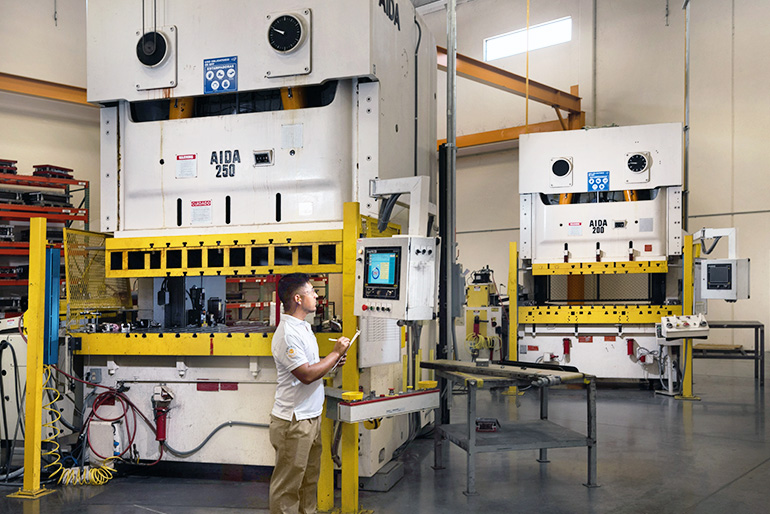Why Metal Stamping is Vital for Creating Durable and Intricate Parts
The Development of Metal Marking Processes: Technologies and Applications
The world of metal stamping processes has experienced a transformative journey noted by continuous innovation and adaptation to fulfill the demands of modern commercial practices. From the standard methods deeply rooted in background to the innovative technologies driving high-speed accuracy, the development of steel stamping has actually been nothing brief of remarkable. As brand-new tooling strategies and automation discover their method into this industry, the ramifications for performance and top quality are extensive. The applications extend throughout a range of industries, each profiting distinctively from the advancements in steel stamping processes.
Typical Metal Marking Strategies
Traditional steel stamping techniques have long been the foundation of manufacturing processes in various markets due to their effectiveness and precision. The process involves developing a steel sheet or coil right into a wanted form by pushing it in between a die and a punch. This approach is extensively made use of for generating large quantities of get rid of high accuracy at a quick rate.
One of the key advantages of standard metal marking methods is the ability to maintain tight tolerances, ensuring that each part satisfies the required specs continually. This level of precision is essential in markets such as vehicle, aerospace, and electronic devices, where even small variances can result in considerable issues.
Furthermore, conventional steel stamping techniques provide affordable remedies for mass manufacturing compared to other producing methods. The capacity to mark components in fast succession minimizes manufacturing time and lowers labor expenses, making it an eye-catching alternative for services seeking to optimize their production processes.
Development of High-Speed Stamping

Among the essential advantages of high-speed marking is its ability to keep precision and consistency also at accelerated handling rates. This precision is important in sectors where tight resistances and intricate designs are needed. Furthermore, high-speed marking enables for the handling of a vast array of products, including aluminum, stainless-steel, and copper, more expanding its applicability across numerous sectors.
Additionally, the appearance of high-speed stamping has actually enabled makers to fulfill the expanding demand for complicated elements in sectors such as automotive, aerospace, and electronic devices (Metal Stamping). By leveraging the speed and precision of high-speed marking modern technology, companies can enhance their competitiveness in a rapidly developing market landscape
Innovations in Tooling Technology
With the development of high-speed stamping allowing improved accuracy and performance in metal developing procedures, the field of steel stamping has seen considerable innovations in tooling modern technology. Tooling technology plays an important function in metal stamping operations, affecting factors such as product high quality, production speed, and overall cost-effectiveness. One key development in tooling innovation is the advancement of smart tooling systems that include sensing units and checking tools to give real-time information on the stamping process. These systems can home spot problems such as device wear or imbalance, permitting for instant modifications to preserve optimal efficiency.
By utilizing these sophisticated products, tooling suppliers can produce dies and mold and mildews that withstand the high pressures and temperature levels entailed in steel marking processes, resulting in longer tool life and improved production effectiveness. On the whole, these advancements in tooling technology have transformed the steel marking industry, allowing producers to accomplish greater degrees of accuracy, performance, and price financial savings.
Integration of Automation in Marking
As automation continues to improve the landscape of metal stamping processes, the integration of automated systems has become progressively common in contemporary manufacturing facilities. Automated systems offer various benefits in metal stamping, including increased efficiency, boosted precision, and improved security. By integrating automation right into stamping processes, manufacturers can minimize cycle times, lessen material waste, and optimize manufacturing throughput.
Among the vital elements of automation in stamping is the usage of robotic arms for jobs such as material handling, component control, and high quality evaluation (Metal Stamping). These robot systems can do repetitive and labor-intensive jobs with speed and accuracy, maximizing human operators to concentrate on more intricate operations. Additionally, automation enables for real-time monitoring and change of stamping procedures, resulting in greater general procedure control and high quality guarantee
Additionally, the assimilation of automation in stamping makes it possible for producers to look at these guys attain regular part top quality, meet tight resistances, and enhance general productivity. As innovation proceeds to advancement, the duty of automation in steel stamping procedures is anticipated to broaden better, driving development and performance in the production industry.
Applications Across Diverse Industries
Incorporating steel marking processes across diverse sectors showcases the flexibility and flexibility of this manufacturing technique. From automotive to aerospace, electronic devices to medical gadgets, steel marking plays a crucial function in the production of a large range of elements. click here to find out more In the automotive market, metal marking is utilized to create intricate components such as body panels, chassis parts, and engine parts with high precision and effectiveness. The aerospace market counts on metal marking for making light-weight yet long lasting elements for airplane and spacecraft. In the electronic devices sector, metal stamping is crucial for producing adapters, get in touches with, and various other small components with tight resistances. Clinical tool suppliers use steel stamping for creating precise components like medical instruments and implants. Additionally, the home appliance industry take advantage of steel stamping procedures to manufacture parts for fridges, washing machines, and various other household appliances. The flexibility of metal stamping processes makes it an important manufacturing technique across numerous sectors, demonstrating its value in modern production procedures.
Conclusion
